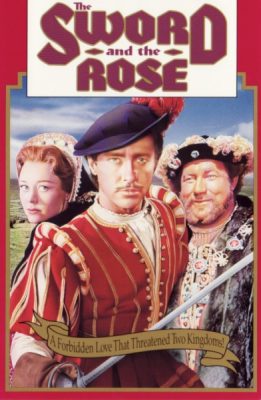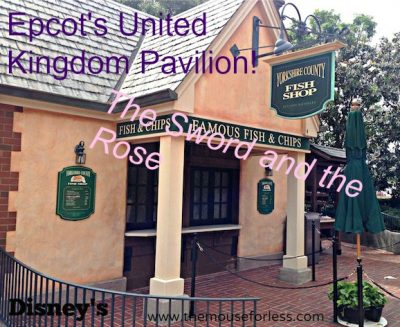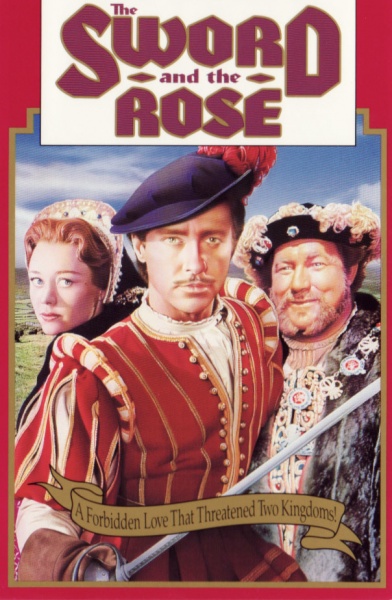
Based on Charles Major’s 1898 novel When Knighthood Was in Flower and loosely on British history, Disney’s The Sword and the Rose was theatrically released on August 8, 1953. The live action drama is ninety-three minutes in length. The Sword and the Rose was the third of four Disney films, following Treasure Island (1950) and The Story of Robin Hood and His Merrie Men (1952) and preceding Rob Roy, the Highland Rogue (1954), produced in the United Kingdom to utilize funds frozen in Europe after World War II. The Sword and the Rose was accompanied in theaters by “Prowlers of the Everglades,” a thirty-three-minute installment of Disney’s “True-Life Adventures” nature documentary series. (1)
Plot Summary
Early in the reign of King Henry VIII (James Robertson Justice), England and France are concluding a war. In the peace negotiations, Henry eagerly agrees to have his sister Princess Mary Tudor (Glynis Johns) married to the elderly French monarch, King Louis XII (Jean Mercure). Although said terms appear routine enough, Mary exudes an intense independent streak and refuses to abide by her brother’s wishes. Instead, the princess flees Windsor Castle and hastens to Bristol Harbour, where the man she truly loves, a commoner named Charles Brandon (Richard Todd), is about to depart on a voyage to North America. The affection being reciprocal, Brandon agrees to allow Mary to impersonate a male page and join him on the voyage. Unfortunately for Mary and Brandon, the crew quickly discerns the scheme, forces the duo back ashore, and ensures that Brandon is locked in the Tower of London, which is under the control of the duplicitous Duke of Buckingham (Michael Gough). Now, Henry is urged to sentence Brandon to death for kidnapping the princess, and Mary is backed into a corner. Can true love possibly prevail over the diplomacy of powerful European dignitaries?
Characterization
The distinctive personalities of the various characters in The Sword and the Rose are often masked by courtly formality and verbose period dialogue. As such, the players in this flick are less overtly bombastic and less memorable than similar characters in other Disney films. The devious nature of the Duke of Buckingham, for example, is comparable to that of Jafar from Aladdin (1992), and the independent nature of Mary is comparable to that of Ariel from The Little Mermaid (1989), but the more overt demonstration of the respective traits by the latter character in each scenario permits the formation of a greater emotional connection with viewers than is the case with The Sword and the Rose.
Peter Ellenshaw
The Sword and the Rose greatly benefited from the work of special effects guru Peter Ellenshaw, who was named a Disney Legend in 1993. (2) Ellenshaw, an England native who had broken onto the scene in Disney’s first two British productions, later recalled that he contributed sixty-two matte paintings to The Sword and the Rose and that he finished two such paintings a week over a twenty-seven-week period. (3) Ellenshaw’s numerous matte paintings in The Sword and the Rose include a distant river and castle in the shot immediately following the end of the Volta dance at Mary’s ball, a similar but more elaborate setting in the shot when Brandon inspects the girth on Mary’s horse, images outside the castle’s windows, ships at Bristol Harbour, settings off the side of the road and over a high wall in the shots following the banishment of Brandon and Mary from the ship, and the distant castle during the scene where Mary and Louis XII ride their horses.
In 1953, Ellenshaw followed Walt Disney back to the United States to do yeoman’s work on 20,000 Leagues Under the Sea (1954), and he continued to contribute matte paintings and other effects to Disney films through Dick Tracy (1990).
For more information on Ellenshaw’s effects, check out my review of Darby O’Gill and the Little People (1959).
Action
Action sequences are interspersed throughout The Sword and the Rose. Along the way, viewers witness a series of wrestling matches, a confrontation between Brandon and the Duke of Buckingham at the entrance to Mary’s ball, intense equestrianism, archery, a scuffle aboard the ship destined for the New World, a daring nighttime escape by Brandon from the Tower of London, and an extended final battle.
Additionally, a combination of elaborate costumes, dance scenes, and regal music augment the atmosphere of the film.
Humor
The Sword and the Rose is not a comedy and features minimal funny moments. Of note, Mary whiffs on the shuttlecock while playing badminton and proceeds to intentionally serve the birdie into the face of her lady-in-waiting, Lady Margaret (Jane Barrett); Margaret exudes glee in dancing with Brandon; and when Mary, upon hearing that Brandon is destined to endure “the ceremonial ax,” asks Henry if her love must die, the king casually replies, “it’s the usual result when the head is separated from the body.”
Relationship to Other Disney Films
Glynis Johns subsequently contributed to Rob Roy, the Highland Rogue, Mary Poppins (1964), and The Ref (1994) for Disney. Johns was named a Disney Legend in 1998.
Richard Todd, who was named a Disney Legend in 2002, held the title roles in both The Story of Robin Hood and His Merrie Men and Rob Roy, the Highland Rogue.
The Sword and the Rose was the second of four Disney films to be directed by Ken Annakin, who, like Todd, was named a Disney Legend in 2002. Annakin had previously directed The Story of Robin Hood for Disney, and he subsequently directed Third Man on the Mountain (1959) and Swiss Family Robinson (1960) for the studio.
In addition to Disney’s first four live action films of the 1950s, The Three Lives of Thomasina (1963), One of Our Dinosaurs Is Missing (1975), and Unidentified Flying Oddball (1979) were filmed in the United Kingdom.
In the Parks
Princess Mary does not greet guests at Walt Disney World or Disneyland, but her counterparts from Disney’s animated classics regularly appear in the parks and resort restaurants.
At Walt Disney World, England and France are represented in Epcot’s World Showcase.

Overall
Although the characters in The Sword and the Rose are somewhat flat, a suspenseful plot and colorful settings make the film an enjoyable watch.
Notes
1) W., A. “Sword and the Rose,’ Disney Romance made in England with British Cast, Bows at Rivoli.” New York Times (1923-Current File), Aug 20, 1953.
2) “Sword and the Rose, The (film).” D23: The Official Disney Fan Club. Accessed April 21, 2018. https://d23.com/a-to-z/sword-and-the-rose-the-film/.
3) “Peter Ellenshaw – Matte Painter / Part 2 of 6,” 146Yamagata. YouTube. July 03, 2010. Accessed April 21, 2018. https://www.youtube.com/watch?v=oUs214sAkrs&t=312s. 4:16 [minutes and seconds into segment]-6:38.
What do you think of The Sword and the Rose? Let me know in the comments!
Sponsored Ad: Would you like to help support The Mouse For Less website in continuing their mission of being THE Disney vacation planning resource? You can do so by purchasing The Sword and the Rose from our Affiliate Link through Amazon. Thanks so much for your support!
Did you like this article? Make sure to share it with your friends! Check below for easy ways to share!
Incoming search terms:
- the rose and the sword movie
- https://www themouseforless com/blog_world/movie-review-the-sword-and-the-rose/

